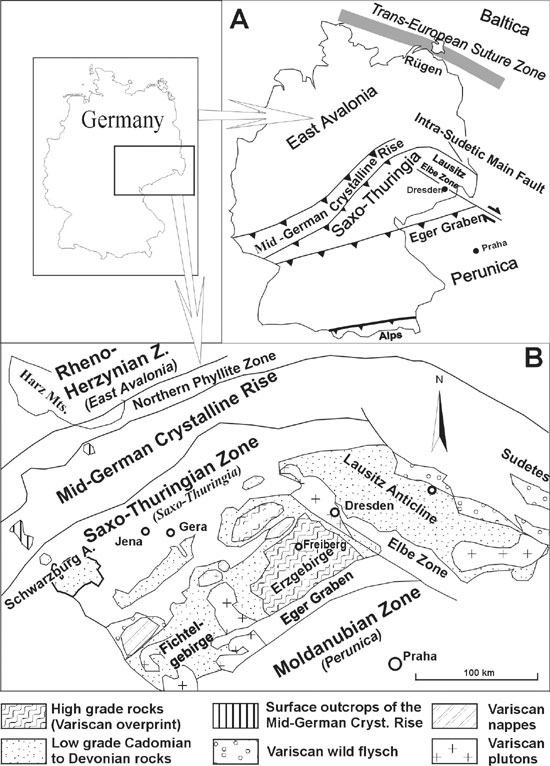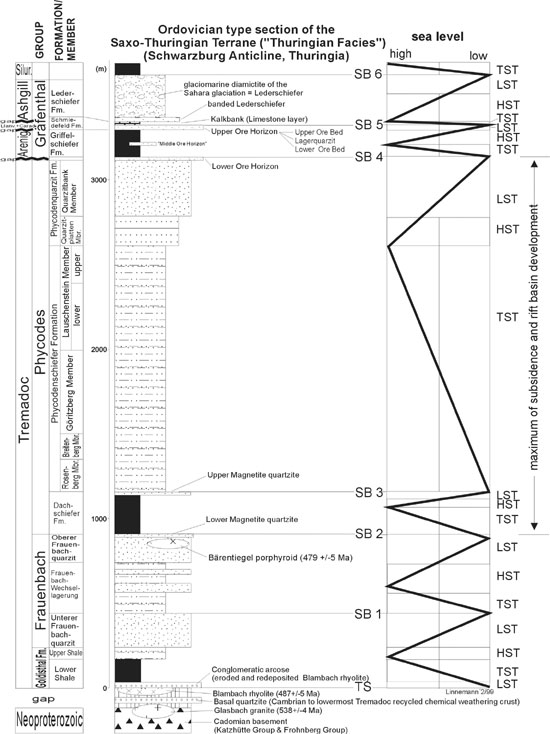
Revision of trilobites of the Griffelschiefer Formation (Ordovician, Schwarzburg anticline, Germany): preliminary results
Jaroslav MAREK1, Konrad BARTZSCH2, Kerstin DROST3, Oldrich FATKA1, Petr KRAFT1 and Ulf LINNEMANN3
1 Charles University, Institute of Geology and Palaeontology, Albertov 6, 128 43 Prague 2, Czech Republic. E–mail: kraft@prfdec.natur.cuni.cz
2 Verfahrenstechnisches Institut Saalfeld GmbH, PF 1162, Saalfeld, D–07302, Germany.
3 Staatliche Naturhistorische Sammlungen Dresden, Museum für Mineralogie und Geologie, Königsbrücker Landstr. 159, D–01109 Dresden, Germany.
Key words: Trilobites. Stratigraphy. Griffelschiefer Formation. Ordovician. Thuringia.
Introduction
Saxo–Thuringia is a part of the Armorican Terrane Collage consisting of Cadomian basement and early Palaeozoic overlap sequences (Linnemann and Buschmann, 1995). The Schwarzburg Anticline represents the Ordovician type section of the Saxo–Thuringian Terrane. The Ordovician sediment pile of about 3500 m thickness contains siliciclastic shelf deposits (quartzites, siltstones, shales) with intercalations of limestone and oolithic iron ores. The top of the succession is a 250 m thick glaciomarine tillite. These successions were deposited on the eroded Avalonian–Cadomian belt at the margin of Gondwana and are subdivided into the Goldisthal, Frauenbach, Phycodes and Gräfenthal groups. Biostratigraphical (Linnemann and Heuse, 2000) and geochronological data (Linnemann et al., 2000) indicate a stratigraphical hiatus between the Cadomian basement and overlying siliciclastic deposits covering the entire Cambrian and the early Tremadoc (Cadomian unconformity). About 3000 m of the Ordovician sediments were accumulated during the Tremadoc, whereas a very condensed sedimentation or depositional gaps occur from Llanvirn to early Ashgill. These extremely varying sedimentation rates are interpreted as caused by a rift setting (Linnemann and Heuse, 1998) with maximum subsidence rates in Tremadoc and uprising block shoulders, which cut off the sediment supply in the Middle Ordovician. Two hundred and fifty m of glaciomarine diamictite with a mid–Ashgillian thin limestone layer directly below are a result of the Hirnantian Glaciation in the uppermost Ordovician.
The Griffelschiefer Formation of the Gräfenthal Group reaches up to 140 m in thickness and comprises very dark grey shales with thin silt layers increasing to the top. A tempestitic Fe–chlorite–bearing quartzite and a thin carbonate layer with cone–in–cone structures are developed locally (Ellenberg et al., 1992).
The designation "Griffelschiefer" (now Griffelschiefer Formation) has been proposed by Richter (1851) for the more or less heavily cleaved, anchimetamorphoused dark grey to black clay shales (Tonschiefer) with subordinate admixture of siltstones with an iron ore horizon at its base. The stratigraphic position is thought to lie within the interval? Middle/Upper Arenig to the Arenig/Llanvirn boundary interval (based on the contained fossils).
History of research
Since the 1840s, trilobites and other fossils have been collected continuously, but they occur very rarely in the Griffelschiefer Formation. During active quarrying and subsequent splitting of the rocks, usually only 2 to 3 specimens were found per year. Today the chances of finding new material is extremely low.

Figure 1. Location of Saxo–Thuringia. A. present day distribution of Peri–Gondwanan terranes as well as important geological structures in Germany and bordering countries. B. Tectonostratigraphic units of Saxo–Thuringia and adjoining areas as well as the position of some deep drillings and locations concerning this paper (please note: The Mid–German Crystalline Rise do not belong to Saxo–Thuringia). (after Linnemann et al., 2000)

Figure 2. Lithostratigraphy, sea level fluctuations and sequence stratigraphy of the Ordovician type section of the Saxo–Thuringian Terrane (Thuringian facies series, Schwarzburg Anticline). (after Linnemann and Heuse, 1998, 2000). TS = Transgressive surface, SB = Sequence boundary, TST = Transgression systems tract, HST = Highstand systems tract, LST = Lowstand systems tract.
The earliest finds of Ordovician trilobites in the "Griffelschiefer" were made by Engelhardt and von Uttenhoven (both "Bergrath" – state mining consultants in Steinach between 1840s and 1860s). Already during 1860s, the stratigraphic importance of fossils was discussed and consulted with Sir Roderick Murchison and Joachim Barrande, who determined their age as Lower Silurian (= Ordovician in recent meaning). Other trilobite specimens were collected also during field mapping by Loretz (1885). The quarring activities increased to the end of 19th century, and the "Griffelschiefer" was actively exploited in numerous small quarries. The fossils attracted more attention and thus the major part of the known fossils comes from beginning of the 20th century.
Localities
Volk (1960) reviewed of the stratigraphic distribution of the "Griffelschiefer" trilobites and mentioned more than twenty fossil sites, mainly quarries, from which all the material originated. The principal sites were situated in the surroundings of Steinach on the following hills: Wasserberg (two quarries), Fellberg (five quarries), Kalte Leite (one quarry), Groser Tierberg (eleven quarries), Sumpf (one quarry), Hoher Schuss (three quarries).
Palaeontology of the Griffelschifer Formation
A project bringing together and documenting all the existing macrofossil specimens has been instigated. The source data for the revision are as follows:
Trilobites: The following taxa have been documented: Asaphus luthardti Freyberg, 1923; Asaphus marginatus Richter, 1872; Asaphus cf. radiatus Salter, 1864 (= Hungioides graphicus Richter et Richter, 1954); Colpocoryphe inopinata (Novák in Perner, 1918); Calymene sp.; Calymene pulchra Barrande (= Prionocheilus pulcher (Barrande, 1846)); Ceratocephala sp.; Hemigyraspis desiderata (Barrande, 1872) (= Asaphellus desideratus (Barrande, 1872)); Hemigyraspis sp.; Hungioides graphicus Richter et Richter, 1954; ? Hungioides sp.; Illaenus loretzei Freyberg, 1923; Illaenus sp.; Megalaspis gladiator Fritsch, 1901; Megalaspis cf. gladiator Fritsch, 1901; Megalaspis sp.; Nileus sp.; Ogygia cf. corndensis Murchison, 1839 (= Hemigyraspis desiderata (Barrande, 1872)); Ptychocheilus discretus Barrande (= Bohemopyge discreta (Barrande, 1872)).
[Volk (1960), Stratigraphische Kommission Deutschlands (1997)].
Graptolites: Four taxa have been documented: Didymograptus (Expansograptus) cf. D. hirundo Salter, 1863, Tetragraptus headi Hall, Didymograptus extensus Hall, D. gracilis Tornquist.
[Heuse et al., (1994), Stratigraphische Kommission Deutschlands (1997), Maletz and Erdtmann (1999)].
Trace fossils: Bifasciculus radiatus Volk, 1960, Planolites montanus Richer, 1937, Tomaculum problematicum Groom, 1902.
[Stratigraphische Kommission Deutschlands (1997)].
Microfossils: Acritarcha: Known eighteen species of the genera: Acanthodiacrodium, Baltisphaera, Baltisphaeridium, Coryphidium, Leiofusa, Striatotheca, Tectitheca, Veryhachium [Heuse (2000), Stratigraphische Kommission Deutschlands (1997), Burmann (2001)]
Chitinozoa: Only one form established – Dicranochitina sp. (= ? Sagenachitina sp.). [Stratigraphische Kommission Deutschlands (1997), Burmann (2001)].
Biostratigraphy and Palaeogeography of the Schwarburg Antikline has been discussed by von Freyberg (1923), Erdtmann (1991), Linnemann and Heuse (1998), Heuse (2000), Servais et al., (2000).
The revision has also revealed the presence of a poorly diversified and preserved mollusc fauna of gastropods, bivalves, cephalopods and hyolithids.
Acknowledgements
This study was supported by DFG grant Li 521/14–1 and by the Grant of Ministry of Education (Nº CEZ: J13/98:113100006).
References
Burmann, G. 2001. Acritarchen von Stadtsteinach/Frankenwald und die biostratigraphische Stellung des Griffelschiefers (Arenig) im Saxothuringikum nebst Bemerkungen zum Hauptquartzit und zur Dicranochitina–Provinz. Neues Jahbuch für Geologie und Paläontologie, Abhandlungen, 220(1): 25–62.
Ellenberg, J., Falk, F. and Lützner, H. 1992. Siliciclastic shelf sedimentation of Early Paleozoic deposits in the Thüringer Schiefergebirge (Thuringian Slate Mountains). In: Falk, F. (Ed.), 13th IAS Regional Meeting of Sedimentology (Guidebook): 133–158, Jena (Friedrich Schiller Universität).
Erdtmann, B.–D. 1991. The post–Cadomian Early Palaeozoic Tectonostratigraphy of Germany (Attempt at an analytical review). Annales de la Société Gélogique de Belgique, 114 (1): 19–43.
Freyberg, B. 1923. Die Fauna und Gliederung des Thüringer Untersilurs. Zeitschrift der Deutschen Geologischen Gesellschaft, 74(1): 237–276.
Heuse, T. 2000. Biostratigraphy and biofacies of the Ordovician of Saxothuringia: a review. In: Erdtmann, B.–D. and Kraft, P. (Eds.): Pre–Variscan terrane analyses of "Gondwanan Europe". Acta Universitatis Carolinea, Geologica, 42(3/4): 423–431.
Heuse, T., Erdtmann, B.–D. and Kraft, P. 1994. Early Ordovician microfossils (acritarchs, chitinozoans) and graptolites from the Schwarzburg Anticline, Thuringia (Germany). Veröff. Naturhist. Mus. Schleusingen, 9: 41–68.
Linnemann, U. and Buschmann, B. 1995. Die cadomische Diskordanz im Saxothuringikum (oberkambrisch–tremadocische overlap–Sequenzen). Z. geol. Wiss., 23: 707–727.
Linnemann, U., Gehmlich, M., Tichomirowa, M., Buschmann, B., Nasdala, L., Jonas, P., Lützner, H. and Bombach, K. 2000. From Cadomian subduction to Early Paleozoic rifting: the evolution of Saxo–Thuringia at the margin of Gondwana in the light of single zircon geochronology and basin development (Central European Variscides, Germany). In: Franke, W., Haak, V., Oncken, O. and Tanner, D. (Eds.), Orogenic Processes: Quantification and modelling in the Variscan Belt, Geol. Soc. London, Special Pub., 179: 131–153.
Linnemann, U. and Heuse, T. 2000. The Ordovician of the Schwarzburg Anticline: Geotectonic setting biostratigraphy and sequence stratigraphy (Saxothuringian Terrane, Germany). Z. dt. geol. Ges., 151: 471–491.
Linnemann, U. and Heuse, T. 1998. Introduction to the Pre– Symposium Excursion (part III): The Ordovician of the Schwarzburg Anticline (Saxo–Thuringian Terrane): biostratigraphy and sea level fluctuations. In: Linnemann, U., Heuse, T., Fatka, O., Kraft, P., Brocke, R. and Erdtmann, B.–D. (Eds.): Pre–Variscan terrane analyses of Gondwanan Europe. Schriften des staatlichen Museums für Mineralogie und Geologie zu Dresden, 9: 7–13.
Maletz, J. and Erdtmann, B.–D. 1999. Ordovician graptolites in Germany. In: Dzik, J., Linnemann, U. and Heuse, T. (Eds.), Excursion and guide Poland and Germany, VIIIth ISOS: 48–50.
Richter, R. 1851. Erläuterungen zur geognostischen Übersichtskarte des ostthüringischen Grauwakkengebietes. Zeitschrift der Deutschen Geologischen Gesellschaft, 3: 536–554..
Richter, R. 1872. Untersilurische Petrefakten aus Thüringen. Zeitschrift der Deutschen Geologischen Gesellschaft, 24: 79–82.
Richter, R. and Richter, E. 1954. Hungioides graphicus n. sp. im Thüringer Griffelschiefer (Tril., Ordov.). Senckenbergiana, 34(4/6): 339–345.
Servais, T., Brocke, R., Erdtmann, B.D.E., Fatka, O. and Heuse, T. 2000. The importance of acritarchs in Ordovician biostratigraphy and palaeobiogeography in Germany. In: Erdtmann, B.–D. and Kraft, P. (Eds.). Pre–Variscan Terrane Analyses of "Gondwanan Europe". Acta Universitatis Carolinae, Geologica, 42(3/4): 495–500.
Stratigraphische Kommission Deutschlands 1997. Stratigraphie von Deutschland II – Ordovizium, Kambrium, Vendium, Riphäikum. Teil 1. Thüringen, Sachsen, Ostbayern. Courier Forschungs–Institut Senckenberg, 200: 1–147.
Volk, M. 1960. Über Trilobiten aus dem Griffelschiefer des Ordoviziums von Steinach (Thüringen) und Umgebung. Geologische Blätter für NO–Bayern, 10(1): 2–12.
Received: February 15, 2003
Accepted: June 15, 2003